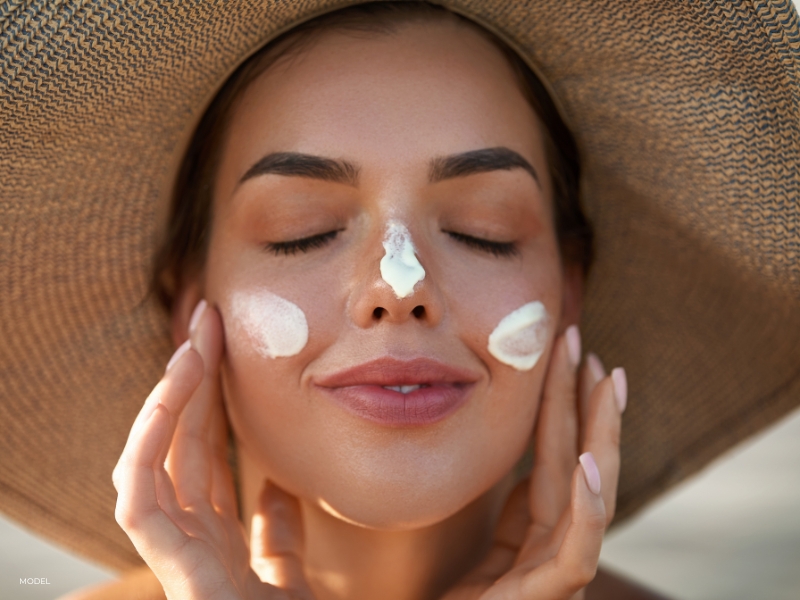Summer is almost here, but before you step out into the sun and get your glow on, it’s important to understand how to best protect your skin from the stronger UV rays. Learn everything you need to know about sun-damaged skin, from preventing it to treating it
What is Sun-Damaged Skin?
Sun-damaged skin results from prolonged or excessive exposure to ultraviolet (UV) radiation, primarily from the sun. This overexposure triggers a cascade of damaging effects at the cellular level, leading to visible and structural changes in the skin over time. The impact of UV rays can manifest in various ways, ranging from cosmetic concerns to more serious health issues.
What Causes Sun-Damaged Skin?
Sun-damaged skin results from excessive exposure to ultraviolet (UV) light, originating from the sun and artificial sources like tanning beds. Both UVA and UVB rays contribute to this damage. UVA rays penetrate deeply, causing premature aging, wrinkles, and loss of skin elasticity. UVB rays affect the surface layers, leading to sunburns and elevating skin cancer risk. Prolonged UV exposure can alter skin cell DNA, resulting in photoaging, hyperpigmentation, increased signs of aging, and an increased likelihood of developing skin cancer.
How to Prevent Sun Damage
Preventing sun damage is the number one way to retain your youthful glow. The most critical step to take in preventing sun damage is to wear a reliable, potent sunscreen every day. While every day might sound like a lot, UV rays are present year-round and can still impact you even on cold, winter days. Second, limit your overall sun exposure as best you can. Try to stay more in the shade when possible. Wear protective hats and clothing to better block out the harmful sun rays.
How to Tell If You Have Sun-Damaged Skin
Typically, someone can tell if you have sun-damaged skin through simple observation, as the visual effects of it can be observed with the naked eye. However, the visible effects of sun damage don’t always appear right away. Sun damage manifests in various ways over time, from immediate sunburns and tanning to short-term fine lines, wrinkles, and pigmentation, and long-term issues like deep wrinkles and skin cancer. Visible signs include wrinkles, age spots, redness, and broken blood vessels. Sun damage can also impact the skin’s elasticity, resulting in less firm skin and potentially jowls.
What are the Effects & Risks of Sun-Damaged Skin?
Sun-damaged skin can lead to both cosmetic and serious health concerns. Short-term effects include dryness, redness, sunburn, and uneven pigmentation, as UV rays break down the skin’s natural oils and cause irritation. Over time, wrinkles, fine lines, and age spots develop due to the degradation of collagen and elastin. More concerningly, DNA from excessive UV exposure can result in various forms of skin cancer, which is why it is ultra critical to wear powerful sun protection every day, especially if you plan to be outside frequently.

How to Treat Sun-Damaged Skin
Prevention is truly the best treatment, but if you have already noticed sun damage on your skin, there are some effective treatments to reverse the visual aspects of sun damage.
Facial Injections
Specific facial injections are specially curated to treat the effects of sun-damaged skin. As their results are temporary, you don’t have to worry about permanent effects. Neurotoxins like Botox and Dysport efficiently and effectively work to diminish the appearance of wrinkles and fine lines in common areas impacted by the sun, such as around the eyes. If you want to regain lost volume in your face, consider dermal fillers to plump and contour your face in all the right places.
Chemical Peels
Chemical peels are highly customizable treatments that assist in bringing new skin cells to the surface to brighten the appearance of sun-damaged skin. You can select the intensity of your chemical peel from a mild, light peel to a robust, highly impactful peel.
Light Therapy (IPL)
Light therapy, also known as intense pulsated light (IPL), is arguably the most effective way to remove sunspots and hyperpigmentation caused by sun exposure. The machine’s highly precise light targets discolored skin cells, eventually causing those cells to rise to the surface of the skin and gently fall off. Most patients opt to receive this treatment during the fall/winter as it requires minimal exposure to the sun both before and after treatment.
Skincare Products that Help Correct Sun-Damaged Skin
Topical retinols help tremendously with minimizing the appearance of hyperpigmentation, fine lines, and wrinkles caused by excess sun. Retinols essentially speed up the rate of the skin’s natural cellular turnover process. This means that it helps newer, less damaged skin cells reach the upper layers of the skin, creating a more youthful appearance. Typically, retinol is only applied at night as it can increase your skin’s sensitivity to the sun.
Antioxidant and vitamin C serums also achieve impressive results in improving sun-damaged skin. Our selection of potent serums helps purge the skin of oxidative stress that causes cell damage and inflammation. They also further stimulate the building of collagen, which can improve the skin’s overall texture.
Treat Sun-Damaged Skin with the Centre for Pure Skin
Ready to get your glow back? Connect with the Centre for Pure Skin’s elite team of expert aestheticians for a consultation to determine the next best step for you to treat sun-damaged skin and achieve your skincare goals.
